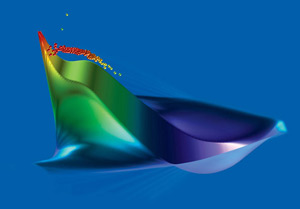

Thursday - November 19, 2009
SLAC Today is
available online at:
http://today.slac.stanford.edu
In this issue:
Crashing the Size Barrier
SLAC Run & Walk Today
SLAC Green Note: New EPA Green Homes Web Site
 |
 |
|
Thursday - November 19, 2009 |
Crashing the Size BarrierLike surfers on monster waves, electrons can ride waves of plasma to very high energies in a very short distance. Scientists have proven that plasma acceleration works. Now they're developing it as a way to dramatically shrink the size and cost of particle accelerators for science, medicine, industry and myriad other uses.  In this simulation of a plasma accelerator, a laser or electron beam (not shown) shoots through the plasma from left to right, shaping electrons in the plasma into a large wave. Surfing the crest of this wave, a bunch of electrons accelerates to high energies in a very short distance. (Image: C. Huang, Los Alamos National Laboratory.)
Accelerator physicists like to think big: big energies, big speeds, big distances. Over the past 50 years, the most common method of increasing the energy of a particle accelerator has been to increase its size. Yet that tactic is reaching a breaking point. While even higher energies are needed to answer many of science's most pressing questions—such as the origin of mass and the identity of dark matter—simply scaling up the current technology is becoming prohibitively expensive. Scientists need less costly, more efficient means of accelerating particles to ever-greater energies. "At this point, the current technology is approaching a plateau," said Mark Hogan, a physicist at SLAC National Accelerator Laboratory. "I'm not sure it's wise to just invest more money in bigger devices; we need a technology revolution. Just as electronics were originally based on vacuum tubes and then later on semiconductors, a similar leap is now needed for particle accelerators." With the type of technological leap Hogan envisions, engineers could build smaller, cheaper, more powerful machines. These machines would not only access new realms of particle physics, but also improve the estimated 17,000 particle accelerators in everyday use around the world—providing radiation treatments for cancer patients, sterilizing food, treating materials used in industry, and disposing of nuclear waste, among dozens of other applications. The technology that many believe may soon spark such a revolution is called plasma acceleration. First proposed in 1979, it creates a powerful electric field within a plasma—a form of matter similar to a gas—that pulls subatomic particles forward as it pushes them from behind, accelerating them to high energies in a short distance. Read more from Symmetry magazine... SLAC Run & Walk TodayLace up your athletic shoes; it’s time for the SLAC Run & Walk! Registration and T-shirt sales begin at 11:45 a.m. on the north side of the Klystron Gallery at Sector 30. The Run and Walk will begin at 12:05 p.m., with the running course totaling 3.8 miles and the walking course covering 2 miles along the linac. All are invited to participate, cheer on the walkers and runners, or buy a T-shirt. Hope to see you there!  SLAC Green Note:New EPA Web Site Provides Tools to Cut Energy Costs and Greenhouse Gas Emissions from HomesHome owners, buyers and renters have a new resource for going green indoors and outdoors. EPA's new Green Homes Web site will help people make their homes greener with tips on reducing energy consumption, carbon footprints, waste generation and water usage, as well as improving indoor air quality. Whether you are a homeowner or a renter, in the market for a new home or making home improvements, this Web site identifies the key environmental and energy issues at hand, and suggests solutions that will add value to your home, reduce energy use and energy costs, fight climate change and help protect your health. |
Events
Access (see all)
Announcements
|
|
| | ||
|
|
||
 <%
Response.AddHeader "Last-modified", getArticleDate()
'Response.AddHeader "Last-modified","Mon, 01 Sep 1997 01:03:33 GMT"
'Monday, December 06, 2010
%>
<%
Response.AddHeader "Last-modified", getArticleDate()
'Response.AddHeader "Last-modified","Mon, 01 Sep 1997 01:03:33 GMT"
'Monday, December 06, 2010
%>View online at http://today.slac.stanford.edu/. |
||